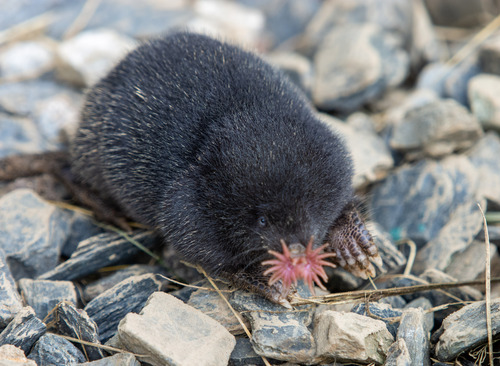
Star-nosed Mole
The star-nosed mole, with its distinctive star-shaped nose, is a master of both land and water. Its sensitive appendages make it a prodigious hunter in murky waters, serving as an ecological balance in its wetland habitat. This remarkable mammal epitomizes adaptation and sensory acuity.
3-4 years
Lifespan
55.0 g
Weight
Length: 15 - 20 cm
Size
Brown, Black, Pink
Color
10 months
Age of Sexual Maturity
1 month
Age of Weaning
4 mph
Top Speed
Least Concern
Conservation Status
Stable
Population Trend
Characteristics
Condylura cristata, commonly known as the star-nosed mole, inhabits wet lowland areas of North America. It is easily recognized by its unique star-shaped nose, which has 22 fleshy appendages. This mole is an excellent swimmer, often hunting aquatic prey, and can detect seismic vibrations, aiding its burrowing lifestyle.
Distribution Range of the Star-nosed Mole
Condylura cristata, commonly known as the Star-nosed Mole, is native to North America. Its geographical distribution includes the northeastern United States and southeastern Canada. This species is primarily found in regions such as the Appalachian Mountains and the Great Lakes basin, extending from southern Quebec and Ontario in Canada to the northern parts of Georgia and Virginia in the United States.
Star-nosed Mole's Habitat
Environmental Conditions
The Star-nosed Mole inhabits wetland environments, favoring moist soils in lowland areas. It is commonly found in marshes, swamps, and along the banks of streams and ponds. The environmental conditions typically include a temperate climate with significant rainfall, which maintains the soil moisture necessary for the mole's burrowing lifestyle.
Ecological Niche
Condylura cristata is adapted to a semi-aquatic lifestyle, spending much of its time foraging underwater. Its ecological niche includes roles such as soil aeration through burrowing and controlling insect and invertebrate populations. The species has specialized adaptations, including its star-shaped nose, which is highly sensitive and aids in detecting prey in dark, wet environments.
Copyright @ Nature Style Limited. All Rights Reserved.
 English
English